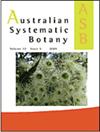使用靶向扩增子测序显示的澳大利亚草树(黄腐病属沥青草科)的系统发育模式
IF 1.6
3区 生物学
Q4 EVOLUTIONARY BIOLOGY
引用次数: 8
摘要
摘要尽管澳大利亚普遍存在硬叶植被,但很少有全大陆采样的系统地理学研究解决有关这种植被干旱化后扩张的问题,以及什么物理障碍与分布或遗传结构模式的中断有关。我们利用质体扩增子测序和核DNA扩增子测序来研究黄疮菌的系统地理学。尽管极低的遗传变异和广泛共享相同的DNA序列在多个物种和跨越显著的地理距离,单倍型分析显示系统地理结构。通过对6个质体位点和137个样本的网络分析,在澳大利亚西南部和中部、澳大利亚东北部和澳大利亚东南部三个地理群体中鉴定出54种单倍型(2种常见,35种单个样本特有),表明区域间基因流动受限。152个样本的nrDNA单倍型网络显示出较少的变异,其中一个单倍型广泛存在,在所有三个质体地理群体和70%的物种中都有发现。nrDNA显示了四组在一个模式中,暗示了至少两个东西分化。在新南威尔士州南部,靠近南部过渡区,发现了一个高单倍型多样性和分化的地理区域。我们的研究结果显示了靶向扩增子测序和每个物种使用多个样本来识别大尺度和精细尺度的生物地理模式的价值。本文章由计算机程序翻译,如有差异,请以英文原文为准。
Phylogeographic patterns of the Australian grass trees (Xanthorrhoea Asphodelaceae) shown using targeted amplicon sequencing
Abstract. Despite the prevalence of sclerophyllous vegetation in Australia, there are few phylogeographic studies with continent-wide sampling addressing questions about the expansion of this vegetation post-aridification, and what physical barriers are associated with breaks in distribution or patterns of genetic structure. We used amplicon sequencing of plastid and nuclear DNA to investigate phylogeography of Xanthorrhoea. Despite extremely low genetic variation and widespread sharing of identical DNA sequence among multiple species and across significant geographic distance, haplotype analyses showed phylogeographic structure. Network analysis of six plastid loci and 137 samples identified 54 haplotypes (two common, 35 unique to single samples) in three geographic groups, south west and central Australia, northern–eastern Australia, and southern–eastern Australia, indicating restricted gene flow among regions. A nrDNA haplotype network of 152 samples showed less variation, with one haplotype being widespread, found in all three plastid geographic groups and 70% of species. nrDNA indicated four groups in a pattern, suggestive of at least two east–west divergences. A geographic area of a high haplotype diversity and divergence was identified in southern New South Wales, near the Southern Transition Zone. Our results showed the value of targeted amplicon sequencing and using multiple samples per species to identify both broad-scale and fine-scale biogeographic patterns.
求助全文
通过发布文献求助,成功后即可免费获取论文全文。
去求助
来源期刊

Australian Systematic Botany
生物-进化生物学
CiteScore
3.10
自引率
12.50%
发文量
12
审稿时长
>12 weeks
期刊介绍:
Australian Systematic Botany is an international journal devoted to the systematics, taxonomy, and related aspects of biogeography and evolution of all algae, fungi and plants, including fossils. Descriptive taxonomic papers should normally constitute a comprehensive treatment of a group. Short papers on individual species and nomenclatural papers must contain significant new information of broader interest to be considered. The prestigious L.A.S. Johnson Review Series is published. Other review articles will also be considered. All papers are peer reviewed.
Australian Systematic Botany is published with the endorsement of the Commonwealth Scientific and Industrial Research Organisation (CSIRO) and the Australian Academy of Science.
 求助内容:
求助内容: 应助结果提醒方式:
应助结果提醒方式:


